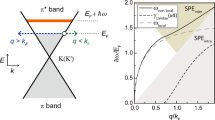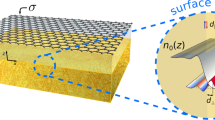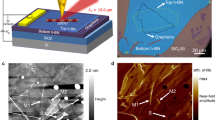Abstract
Plasmons describe collective oscillations of electrons. They have a fundamental role in the dynamic responses of electron systems and form the basis of research into optical metamaterials1,2,3. Plasmons of two-dimensional massless electrons, as present in graphene, show unusual behaviour4,5,6,7 that enables new tunable plasmonic metamaterials8,9,10 and, potentially, optoelectronic applications in the terahertz frequency range8,9,11,12. Here we explore plasmon excitations in engineered graphene micro-ribbon arrays. We demonstrate that graphene plasmon resonances can be tuned over a broad terahertz frequency range by changing micro-ribbon width and in situ electrostatic doping. The ribbon width and carrier doping dependences of graphene plasmon frequency demonstrate power-law behaviour characteristic of two-dimensional massless Dirac electrons4,5,6. The plasmon resonances have remarkably large oscillator strengths, resulting in prominent room-temperature optical absorption peaks. In comparison, plasmon absorption in a conventional two-dimensional electron gas was observed only at 4.2 K (refs 13, 14). The results represent a first look at light–plasmon coupling in graphene and point to potential graphene-based terahertz metamaterials.
This is a preview of subscription content, access via your institution
Access options
Subscribe to this journal
Receive 12 print issues and online access
$259.00 per year
only $21.58 per issue
Buy this article
- Purchase on Springer Link
- Instant access to full article PDF
Prices may be subject to local taxes which are calculated during checkout




Similar content being viewed by others
References
Yen, T. J. et al. Terahertz magnetic response from artificial materials. Science 303, 1494–1496 (2004).
Pendry, J. B., Holden, A. J., Stewart, W. J. & Youngs, I. Extremely low frequency plasmons in metallic mesostructures. Phys. Rev. Lett. 76, 4773–4776 (1996).
Chen, H. T. et al. Active terahertz metamaterial devices. Nature 444, 597–600 (2006).
Wunsch, B., Stauber, T., Sols, F. & Guinea, F. Dynamical polarization of graphene at finite doping. New J. Phys. 8, 318 (2006).
Polini, M., MacDonald, A. H. & Vignale, G. Drude weight, plasmon dispersion, and pseudospin response in doped graphene sheets. Preprint at http://arXiv.org/abs/0901.4528 (2009).
Hwang, E. H. & Das Sarma, S. Dielectric function, screening, and plasmons in two-dimensional graphene. Phys. Rev. B 75, 205418 (2007).
Brey, L. & Fertig, H. A. Elementary electronic excitations in graphene nanoribbons. Phys. Rev. B 75, 125434 (2007).
Vakil Ashkan & Engheta, N. One-atom-thick IR metamaterials and transformation optics using graphene. Preprint at http://arXiv.org/abs/1101.3585 (2011).
Jablan, M., Buljan, H. & Soljacic, M. Plasmonics in graphene at infrared frequencies. Phys. Rev. B 80, 245435 (2009).
Koppens, F. H. L., Chang, D. E. & Abajo, F. J. G. d. Graphene plasmonics: a platform for strong light-matter interaction. Preprint at http://arXiv.org/abs/1104.2068v1 (2011).
Rana, F. Graphene terahertz plasmon oscillators. IEEE Trans Nanotechnol. 7, 91–99 (2008).
Ryzhii, M. & Ryzhii, V. Injection and population inversion in electrically induced p-n junction in graphene with split gates. Jpn. J. Appl. Phys. 2 46, L151–L153 (2007).
Allen, S. J., Tsui, D. C. & Logan, R. A. Observation of 2-dimensional plasmon in silicon inversion layers. Phys. Rev. Lett. 38, 980–983 (1977).
Batke, E., Heitmann, D. & Tu, C. W. Plasmon and magnetoplasmon excitation in two-dimensional electron space-charge layers on gaas. Phys. Rev. B 34, 6951–6960 (1986).
Novoselov, K. S. et al. Two-dimensional gas of massless Dirac fermions in graphene. Nature 438, 197–200 (2005).
Zhang, Y. B., Tan, Y. W., Stormer, H. L. & Kim, P. Experimental observation of the quantum Hall effect and Berry's phase in graphene. Nature 438, 201–204 (2005).
Katsnelson, M. I., Novoselov, K. S. & Geim, A. K. Chiral tunnelling and the Klein paradox in graphene. Nature Phys. 2, 620–625 (2006).
Young, A. F. & Kim, P. Quantum interference and Klein tunnelling in graphene heterojunctions. Nature Phys. 5, 222–226 (2009).
Mak, K. F. et al. Measurement of the optical conductivity of graphene. Phys. Rev. Lett. 101, 246803 (2008).
Nair, R. R. et al. Fine structure constant defines visual transparency of graphene. Science 320, 1308–1308 (2008).
Li, Z. Q. et al. Dirac charge dynamics in graphene by infrared spectroscopy. Nature Phys. 4, 532–535 (2008).
Wang, F. et al. Gate-variable optical transitions in graphene. Science 320, 206–209 (2008).
Bostwick, A., Ohta, T., Seyller, T., Horn, K. & Rotenberg, E. Quasiparticle dynamics in graphene. Nature Phys. 3, 36–40 (2007).
Bostwick, A. et al. Observation of plasmarons in quasi-freestanding doped graphene. Science 328, 999–1002 (2010).
Liu, Y., Willis, R. F., Emtsev, K. V. & Seyller, T. Plasmon dispersion and damping in electrically isolated two-dimensional charge sheets. Phys. Rev. B 78, 201403 (2008).
Tegenkamp, C., Pfnur, H., Langer, T., Baringhaus, J. & WSchumacher, H. Plasmon electron-hole resonance in epitaxial graphene. J. Phys. Condens. Matter 23, 012001 (2011).
Brar, V. W. et al. Observation of carrier-density-dependent many-body effects in graphene via tunneling spectroscopy. Phys. Rev. Lett. 104, 036805 (2010).
Cho, J. H. et al. Printable ion-gel gate dielectrics for low-voltage polymer thin-film transistors on plastic. Nature Mater. 7, 900–906 (2008).
Yamamoto, K., Tani, M. & Hangyo, M. Terahertz time-domain spectroscopy of imidazolium ionic liquids. J. Phys. Chem. B 111, 4854–4859 (2007).
Palik, E. D. Handbook of Optical Constants of Solids (Elsevier, 1998).
Li, X. S. et al. Large-area synthesis of high-quality and uniform graphene films on copper foils. Science 324, 1312–1314 (2009).
Acknowledgements
The authors thank R. Sagelman and B. Boudouris for providing the ion gel and X. Zhang for helpful discussions. This work was supported by an Office of Naval Research MURI award (N00014-09-1066 to L.J., J.H., C.G., A.Z. and F.W.) and the Office of Basic Energy Sciences, US Department of Energy (contract nos DE-AC02-05CH11231 for the Materials Science Division to Y.R.S. and F.W. and DE-AC02-05CH11231 for the Advanced Light Source). F.W. also acknowledges support from a Lucile and William Packard fellowship and a Hellman family fellowship, and L.J. acknowledges the support of a Lam fellowship.
Author information
Authors and Affiliations
Contributions
F.W. and L.J. conceived the experiment. L.J. carried out optical measurements, B.G., J.H., X.L. and C.G. contributed to sample growth and fabrication, and L.J. and F.W. performed theoretical analysis. All authors discussed the results and wrote the paper.
Corresponding author
Ethics declarations
Competing interests
The authors declare no competing financial interests.
Supplementary information
Supplementary information
Supplementary information (PDF 719 kb)
Rights and permissions
About this article
Cite this article
Ju, L., Geng, B., Horng, J. et al. Graphene plasmonics for tunable terahertz metamaterials. Nature Nanotech 6, 630–634 (2011). https://doi.org/10.1038/nnano.2011.146
Received:
Accepted:
Published:
Issue Date:
DOI: https://doi.org/10.1038/nnano.2011.146
This article is cited by
-
Reconfigurable flexible metasurfaces: from fundamentals towards biomedical applications
PhotoniX (2024)
-
Real-space observation of ultraconfined in-plane anisotropic acoustic terahertz plasmon polaritons
Nature Materials (2023)
-
Twist-tunable polaritonic nanoresonators in a van der Waals crystal
npj 2D Materials and Applications (2023)
-
Strong second-harmonic generation by sublattice polarization in non-uniformly strained monolayer graphene
Nature Communications (2023)
-
In-plane hyperbolic polariton tuners in terahertz and long-wave infrared regimes
Nature Communications (2023)



